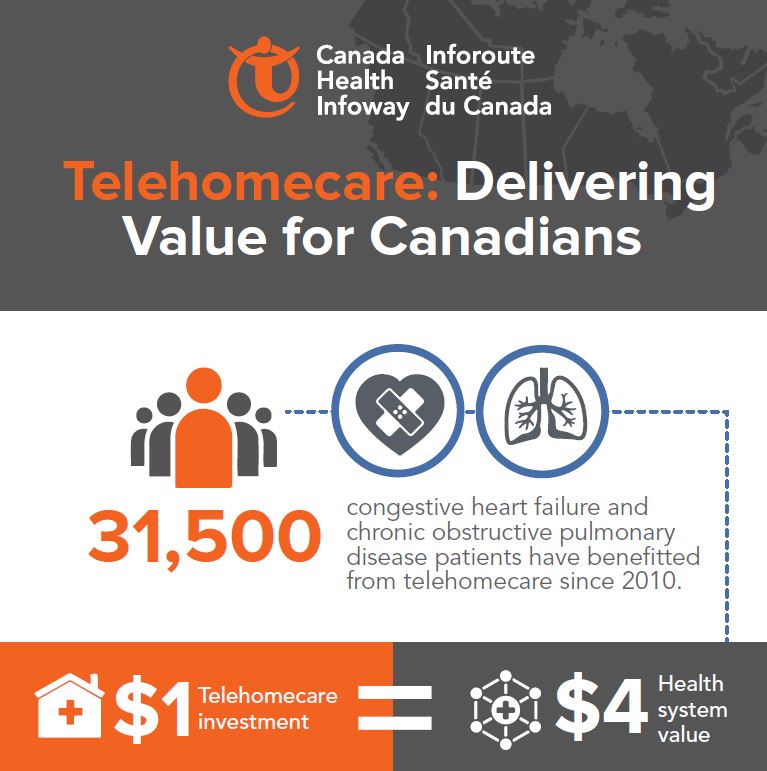A provider (typically a nurse or paramedic) has electronic access to the patient’s information for review, interpretation and coaching opportunities to enhance the patient’s self-management abilities. These programs are available across much of the country and have served 31,500 Canadians since 2010.
Recent telehomecare reports from six projects in five provinces (Ontario, British Columbia, Newfoundland and Labrador, Prince Edward Island and Quebec) involved in the Infoway Telehomecare Program have yielded impressive results. Each project focused on patients living with chronic heart failure (CHF) or chronic obstructive pulmonary disease (COPD) who are considered high users of the health care system. Here are some highlights from what patients reported about their telehomecare experience:
- 92% say the digital health tools are easy to use
- 91% feel more informed about their chronic condition
- 91% are better able to manage their health condition as a result of the program
- 87% feel they have improved quality of life
These survey results confirm that telehomecare contributes to empowerment, better self-management and an improved quality of life for patients. But, does this value justify the cost of these projects, or how can we assess return on investment (ROI)? We took a detailed look into the financial implications using results in these six reports to fully understand how our investments have impacted the health care system and to see if the benefits justify the cost. Our analysis suggests a 400 per cent ROI — that is for every $1 invested in these telehomecare programs, the health system see $4 in value.
Read the reports from six projects in five provinces.
First, let’s look at the costs: looking at all funding to establish and operate these programs for the 31,500 Canadians who have benefitted thus far, the per capita cost has been $1,556. With this infrastructure in place, the incremental costs for new patients is much lower, but for the purpose of this analysis we have used the actual total costs to date.
Although these evaluations look at a range of outcomes, such as satisfaction and quality of life, we focused on the most costly: emergency department (ED) use and hospital stays. There were consistent significant improvements across these programs: reductions in ED use from 35 to 63 per cent and reductions in hospitalizations, 44 to 85 per cent. These are particularly relevant outcomes for the many health systems across the country where capacity in acute care is a critical issue.
We examined the frequency and cost of emergency department use and hospital stays for patients before their participation in a telehomecare program. Of the 1,652 patients included in the six data sets reviewed, patients averaged 2.93 ED visits annually and 1.33 hospitalizations totaling 9.57 days annually. We applied the Canadian Institute for Health Information (CIHI) rates of $137 per ED[1] visit and $1,102 per hospital day[1], which equated to $10,951 per patient in hospital and ED costs in the year prior to enrollment.
During and following these programs, ED utilization was reduced by 1.46 visits per year and hospital stays by 6.07 days per year on average. This diminished costs from $10,951 per patient to $4,058, a reduction of $6,893 per patient in the first year alone.
Finally, to calculate the return on investment, we took the $6,893 in cost avoidance during one year compared to the investment of $1,556 per patient generating a return of investment of more than 400%! The investment generated four times the value for the health system.
When we consider the health system impact for the 31,500 patients served since 2010, that is $217 million in cost avoidance on a $49 million investment for a net value of $168 million. That equates to nearly 46,000 ED visits and 27,000 hospitalizations being avoided.
Now, is the time to scale these programs as we see the cost per patient continuing to decline while economies of scale grow, technology costs drop and existing infrastructure leveraged to handle higher telehomecare patient volumes. Check out this list of some of the active telehomecare programs to see if there is one near you and, if not, ask your physician or health authority.
- Home Health Monitoring for Yukoners
- Island Health Home Health Monitoring
- TeleCARE-TéléSOINS Manitoba
- OTN Telehomecare
- Future Health Services
- Télésoins à domicile du RUIS de l’UdeM
- Télésanté du RUIS McGill
- Mise en place des télésoins à domicile au CIUSSS de la Capitale-Nationale
- Eastern Health Remote Patient Monitoring Program
- Prince Edward Island Remote Patient Monitoring Program
Limitations and Assumptions
We assumed the results of the 1,652 patients included in the six evaluations were reflective of the impacts across Canada. The findings from a recent literature review gave us confidence in this assumption. There were differences in the way each of these telehomecare programs were deployed, as described in each of the evaluations. The six evaluations looked at different durations in pre, during and post intervention measurement, so for each we calculated annualized rates of ED and hospital utilization in the pre-phase, as well as the during/post phases. We averaged results from each of the six evaluations, rather than weighting evenly the 1,652 patients — this approach made the results more conservative. While emerging evidence is suggesting that the positive impacts of these programs persists beyond the first year, to be conservative we have included only the value generated in the first year. Finally, the ED and hospitalization avoidance do not represent cash savings for health systems, but instead much needed capacity.
[1] Canadian Institute for Health Information, Access Data and Reports
Have a comment about this post? We’d love to hear from you.




